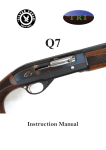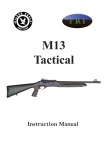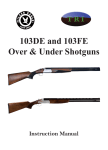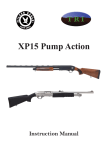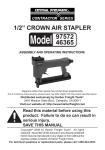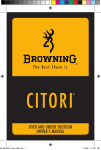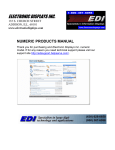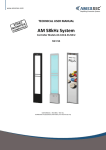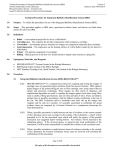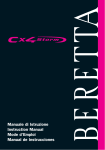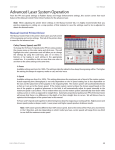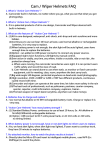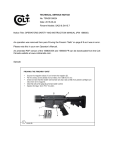Download Sporter - TR Imports
Transcript
Sporter Instruction Manual 12 & 20 ga 2 ALWAYS KEEP THIS MANUAL WITH YOUR FIREARM. INCLUDE IT WITH THE FIREARM WHEN IT CHANGES OWNERSHIP. WARNING: ALL FIREARMS CAN BE DANGEROUS AND CAN CAUSE SERIOUS INJURY, DAMAGE TO PROPERTY OR DEATH. THE FOLLOWING SAFETY RULES ARE AN IMPORTANT REMINDER THAT FIREARM SAFETY IS YOUR RESPONSIBILITY. WARNING: READ THE ENTIRE MANUAL CAREFULLY BEFORE USING THIS FIREARM. MAKE SURE THAT ANY PERSON USING OR HAVING ACCESS TO THIS FIREARM READS AND UNDERSTANDS THIS ENTIRE MANUAL PRIOR TO USE OR ACCESS. WARNING: ALWAYS ENSURE THAT THE SAFETY IS FULLY ENGAGED UNTIL READY TO FIRE! NOTICE: The Manufacturer and/or its Official Distributors assume no liability for product malfunction or for physical injury or property damage resulting in whole or in part from criminal or negligent use of the product, improper or careless handling, unauthorized modifications, use of defective, improper, hand loaded, reloaded or remanufactured ammunition, customer misuse or neglect of the product, or other factors beyond manufacturer’s direct and immediate control. In addition to the Basic Safety Rules, there are other Safety Rules pertaining to the loading, unloading, disassembly, assembly and use of this firearm, located throughout this manual. WE RECOMMEND THE USE OF ORIGINAL SPARE PARTS AND ACCESSORIES. THE USE OF OTHER MANUFACTURERS’ SPARE PARTS AND ACCESSORIES COULD CAUSE MALFUNCTIONS AND/ OR BREAKAGES THAT WILL NOT BE COVERED BY THE SILVER EAGLE WARRANTY. 3 CONTENTS Page BASIC SAFETY RULES 4 NOMENCLATURE 7 DESCRIPTION 9 TECHNICAL FEATURES AND SPECIFICATIONS 10 OPERATION 10 AMMUNITION 12 DISASSEMBLY 16 ROUTINE MAINTENANCE 18 SPECIAL MAINTENANCE 21 20 GAUGE DIFFERENCES 25 OPTIONAL SHIM KIT INSTRUCTIONS 26 WARRANTY INFORMATION 27 4 BASIC SAFETY RULES CAUTION: READ THIS MANUAL CAREFULLY BEFORE USING THE SHOTGUN. CAUTION: FIREARMS CAN BE DANGEROUS AND CAN CAUSE SERIOUS INJURY, DAMAGE TO PROPERTY OR DEATH, IF HANDLED IMPROPERLY. THE FOLLOWING SAFETY RULES ARE AN IMPORTANT REMINDER THAT FIREARM SAFETY IS YOUR RESPONSIBILITY. 1. NEVER POINT A FIREARM AT SOMETHING THAT IS NOT SAFE TO SHOOT. Never let the muzzle of a firearm point at any part of your body or at another person. This is especially important when loading or unloading the firearm. When you are shooting at a target, know what is behind it. Slugs and shot can travel farther than their intended range. If you miss your target or if a projectile penetrates the target, it is your responsibility to ensure that the shot does not cause unintended injury or damage. 2. ALWAYS TREAT A FIREARM AS IF IT WERE LOADED. Never assume that a firearm is unloaded. The only certain way to ensure there are no cartridges in a firearm is to open the chamber and visually and physically examine the inside to see if a round is present. Removing or unloading the magazine will not guarantee that a firearm is unloaded or cannot fire. Shotguns can be checked by cycling or removing all rounds and by then opening and inspecting the chamber so that a visual inspection of the chamber for any remaining rounds can be made. 5 3. STORE YOUR FIREARM SO THAT CHILDREN CANNOT GAIN ACCESS TO IT. It is your responsibility to ensure that children under the age of 18 or other unauthorized persons do not gain access to your firearm. To reduce the risk of accidents involving children, unload your firearm, lock it and store the ammunition in a separate locked location. Please note that devices intended to prevent accidents - for example, cable locks, chamber plugs, etc., - may not prevent use or misuse of your firearm by a determined person. Firearm storage in a steel gun safe may be more appropriate to reduce the likelihood of intentional misuse of a firearm by a child or unauthorized person. 4. NEVER SHOOT AT WATER OR AT A HARD SURFACE. Shooting at the surface of water or at a rock or other hard surface increases the chance of ricochets or fragmentation of the bullet or shot, which can result in the projectile striking an unintended or peripheral target. 5. KNOW THE SAFETY FEATURES OF THE FIREARM YOU ARE USING, BUT REMEMBER: SAFETY DEVICES ARE NOT A SUBSTITUTE FOR SAFE HANDLING PROCEDURES. Never rely solely on a safety device to prevent an accident. It is imperative that you know and use the safety features of the particular firearm you are handling, but accidents can best be prevented by following the safe handling procedures described in these safety rules and elsewhere in the product manual. To further familiarize yourself with the proper use of this or other firearms, take a Firearms Safety Course taught by an expert in firearms use and safety procedures. 6. PROPERLY MAINTAIN YOUR FIREARM. Store and carry your firearm so that dirt or lint does not accumulate in the working parts. Clean and oil your firearm, following the instructions provided in this manual, after each use to prevent corrosion, damage to the barrel or accumulation of impurities which can prevent use of the firearm in an emergency. Always check the bore and chamber(s) prior to loading to ensure that they are clean and free from obstructions. Firing with an obstruction in the barrel or chamber can rupture the barrel and injure you or others nearby. In the event you hear an unusual noise when shooting, stop firing 6 immediately, engage the manual safety and unload the firearm. Make sure the chamber and barrel are free from any obstruction, such as part of a cartridge stuck inside the barrel due to defective or improper ammunition. 7. USE PROPER AMMUNITION. Use only factory-loaded, new ammunition manufactured to industry specifications: CIP (Europe and elsewhere), SAAMI® (U.S.A.). Be certain that each round you use is in the proper gauge and type for the particular firearm. The caliber or gauge of the firearm is clearly marked on the barrel. The use of reloaded or remanufactured ammunition can increase the likelihood of excessive cartridge pressures, case-head ruptures or other defects in the ammunition that can cause damage to your firearm and injury to yourself or others nearby. 8. ALWAYS WEAR PROTECTIVE GLASSES AND EARPLUGS WHEN SHOOTING. The chance that gas, gunpowder or metal fragments will blow back and injure a shooter who is firing a gun is rare, but the injury that can be sustained in such circumstances can be severe, including the possible loss of eyesight. A shooter must always wear impact resistant shooting glasses when firing any firearm. Earplugs and other high-quality hearing protectors help reduce the chance of hearing damage from shooting. 9. NEVER CLIMB A TREE, FENCE OR OBSTRUCTION WITH A LOADED FIREARM.. Open and empty the chamber(s) of your firearm and engage the manual safety before climbing or descending a tree or before climbing a fence or jumping over a ditch or other obstruction. Never pull or push a loaded firearm toward yourself or another person. Always unload a firearm, visually and physically check to see that the magazine, loading mechanism and chamber are unloaded, and action is open before handing it to another person. Never take a firearm from another person unless it is unloaded, visually and physically checked to confirm it is unloaded, and the action is open. 7 10. AVOID ALCOHOLIC BEVERAGES OR JUDGEMENT/REFLEX IMPAIRING MEDICATION WHEN SHOOTING. Do not drink and shoot. If you take medication that can impair motor reactions or judgement, do not handle a firearm while you are under the influence of the medication. 11. NEVER TRANSPORT A LOADED FIREARM. Unload a firearm before putting it in a vehicle (chamber empty, magazine empty). Hunters and target shooters should load their firearm only at their destination, and only when they are ready to shoot. If you carry a firearm for self-protection, leaving the chamber unloaded can reduce the chance of an unintentional discharge. 12. LEAD WARNING. Discharging firearms in poorly ventilated areas, cleaning firearms, or handling ammunition may result in exposure to lead and other substances known to cause birth defects, reproductive harm, and other serious physical injury. Have adequate ventilation at all times. Wash hands thoroughly after exposure. CAUTION: It is YOUR responsibility to know and abide by federal, state and local laws governing the sale, transportation and use of firearms in your area. WARNING: This firearm has the capability of taking your life or the life of someone else! Always be extremely careful with your firearm. An accident is almost always the result of not following basic firearm safety rules. For information about Firearm Safety Courses in your area, please visit the National Rifle Association’s web site at www.nra.org. A Action Group A1 Action bar A2 Power link A3 Power buffer A4 Gas piston with ring A5 Action spring BBarrel NOMENCLATURE B1 B2 B3 B4 B5 B6 B7 8 Index lug Barrel breech Locking cove Gas cylinder Ventilated rib Fiber optic bead Muzzle C Breech Bolt C1 Breech bolt body C2 Firing pin C3 Extractor C4 Bolt handle M Magazine Tube PPlug RReceiver R1 Bolt Release Button R3 Carrier Stop Push Button R4 Loading Gate R5 Ejection Port SStock S1 Buttstock S2 Fore end S3 S4 S5 S6 T T1 T2 T3 T4 T5 T6 T7 9 Fore end insert Magazine cap Recoil pad Buttstock sling swivel Trigger Assembly Safety button Trigger Trigger guard Hammer Carrier Trigger Assembly Retaining Pin Retaining pin screw GENERAL DESCRIPTION HIGH CHROME-MOLY BARREL Barrel is bored from state-of-the industry solid bar C4140 German steel. Plated with hard chrome, it is fully compatible with steel and heavy shot. ANTI-GLARE RIB A full 10mm-wide rib promotes fast target acquisition. Reverse concave-ridged surface prevents glare, and fiber-optic front sight stands out in a wide variety of lighting conditions. STOCK Buttstock and fore-end are of beautiful Turkish walnut (wood-stocked models) with a matte (oil) or gloss finish. Deep ventilated recoil pad has a hard polished rubber heel to prevent hanging up on clothing for quick shouldering. GAS SYSTEM Simplified single-piston gas system is easily maintained, and reliably cycles loads from 1oz to 1 3/4 oz. TRIGGER ASSEMBLY Trigger plate and guard are all-metal, enhancing durability and avoiding the problem of parts becoming brittle in extremely cold weather. Large trigger guard permits quick hand positioning even while wearing gloves. PITCH AND CAST ADJUSTMENT A set of shim kits (not included - available through our online store) permits the raising or lowering of stock pitch, and right or left cast. ACCESSORIES A number of useful replacements and add-ons are available for your Sporter, including: extra barrels from 20” (slug barrel with rifle sights) to 30”; extra choke tubes; replacement stocks, walnut and synthetic; additional shim kits for stock adjustment; convenient gun cases. See your dealer or www.trimports.com. 10 TECHNICAL FEATURES AND SPECIFICATIONS Gauge Barrel Chamber Barrel Rib Front Sight Operation Locking System Receiver Safety Magazine Capacity Stock Length of Pull Drop Weight 12 76mm; accepts 23/4 and 3 inch shells Steel with chrome-plated bore Ventilated, 10mm anti-glare Fiber optic Semi-automatic, gas operated Elevated locking block Lightweight alloy Cross-bolt, uni-directional 4 shells, removable-plug-restricted to 2 Turkish Walnut 14.5 inches, + or - 1/4 inch DAC: 1.5” DAH: 2.25” 6lb 15oz (varies with barrel length and wood density) OPERATION NOTE: numbers listed in the text refer to illustrations beginning on page 22. OBSTRUCTION & CHOKE TUBE CHECK Check the barrel to ensure there are no obstructions in the chamber and bore. This is extremely important because serious injury can result to the user or to nearby persons if a cartridge is fired in an obstructed barrel or chamber. Check the inside of the barrel prior to completely assembling the firearm and before use; if the firearm is already assembled the following procedure should be followed: • Follow the instructions in the “Disassembly” section and remove the barrel from the shotgun. • After removing the barrel, look right through the barrel from the rear and make sure there are no obstructions, even minor ones. • If an obstruction in the barrel is detected, a competent gunsmith must remove the obstruction. Reinspect the shotgun before firing. • Remount the barrel, following the instructions in the “Reassembly” section. 11 Check the condition of the choke tubes: • Make sure there is a choke tube installed! Shooting without a choke tube installed may irreparably damage the barrel! • Always check the appearance and cleaning of the choke tubes before using the shotgun. • Check correct tightness in the barrel with the wrench provided. • Never use choke tubes that show signs of defects, warping or incrustation. • Make sure that the choke tube inserted is appropriate for the intended use and shot type to be used (steel or lead). See “Ammunition”, below. • The application of a light coat of gun grease will make the tube easier to remove, and reduce the deposition of carbon between the tube and barrel. MOUNTING THE BARREL Your shotgun may be packed with the barrel separate from the stock/receiver/ fore-end assembly. WARNING: All assembly, disassembly and maintenance procedures should be carried out with the firearm unloaded (magazine tube empty, receiver empty and barrel chamber empty). Check that the firearm is unloaded by looking through the ejection port, the loading gate and the chamber. WARNING: During the assembly, disassembly and maintenance procedures, never point a firearm at someone or at hard and flat surfaces. Treat the firearm as if it were loaded. (See paragraphs 1, 2, and 4 of the BASIC SAFETY RULES). CAUTION: If the breech bolt is open and the barrel is not installed, avoid pressing the breech bolt release button and keep your fingers away from the ejection port. Should the breech bolt release button be pressed in this condition, the breech bolt will slam forward and the bolt handle will forcefully strike the forward edge of the ejection port. This may damage the handle and the receiver. • Check the barrel. The bore and chamber must be clean and free of obstructions. • Unscrew the fore-end cap from the magazine tube. (fig 1) • Pull the fore-end off the magazine tube. (fig 2) Keep the metal fore-end insert together with the fore-end. (See “Nomenclature,” above.) • If the piston is on the magazine tube, slide it off. Inspect it carefully for general condition and the proper installation of the piston ring. (fig 3) • Insert the piston into the gas cylinder. (fig 4) WARNING: Never attempt to shoot the firearm without a properly installed gas piston. The action will not cycle and excessive gas pressure may damage 12 the fore-end and injure the shooter or bystanders. When changing barrels, always ensure the piston is in the gas cylinder of the barrel to be installed Assemble the barrel with the stock/receiver/fore-end assembly as follows: • Partially slide the barrel breech into the receiver, ensuring that the piston and gas cylinder slide over the end of the magazine tube. (fig 5) • Allow the barrel breech to push past the breech bolt and seat fully. When the barrel is seated fully, the bolt will be closed. • Slide the fore-end over the gas cylinder and magazine tube. Check that the fore-end is fully seated in the bracket on the face of the receiver. The fore-end is correctly assembled when there is no space between the parts. (figs 6 & 7) • Screw the magazine cap onto the magazine tube and tighten completely. You will feel a ratcheting as the cap engages the spring-loaded retaining pin permanently installed in the fore-end insert. (fig 8) • There should be no play in the fore end. If there is play, remove the cap and fore end. Make sure the fore end insert is installed. (see Nomenclature, above.) AMMUNITION WARNING: The manufacturer and distributor assume no liability for physical injury or property damage resulting from the use of defective, improper, handloaded, reloaded or remanufactured ammunition. Serious damage or injury, even death, may be caused by the use of ammunition that is not suitable, loaded with force, or loaded with obstructions in the barrel. WARNING: Never use cartridges that do not correspond to the indications on the barrel. WARNING: Only use cartridges with a length equal to or less than the chamber length indicated on the barrel. WARNING: To avoid using improper ammunition, always check the characteristics stamped on the cartridge box and on the cartridge. Be sure to use the right cartridge gauge and length for your firearm. STEEL SHOT The barrel and choke tubes are designed for use with factory steel shot cartridges loaded to international standard specifications. When steel shot cartridges are fired, the best results are obtained by using open chokes (C, IC, M). Tighter choke constrictions (IM, F) when using steel shot, do not increase pattern density and will accelerate wear and tear. The use of reloaded or remanufactured ammunition can increase the likelihood of excessive pressure, case rupture or other defects in the ammunition. 13 Your Silver Eagle Sporter is chambered for 3” and shorter shells. You will find markings for the gauge and chamber length on the side of the barrel. The Sporter has been tested with special proof test ammunition in accordance with government quality control standards. NOTE: Because of the precise CNC machine tolerances of the parts in your Sporter, a break-in period may be required before you shotgun will cycle consistently with light (1oz) loads. If you experience a failure to cycle with these loads, we recommend that you fire 200-300 normal field loads (11/8oz or greater) to allow for proper wear-in. MAGAZINE CAPACITY To ensure compliance with Federal and state laws governing the hunting of migratory birds, your Sporter ships with a magazine plug restricting the magazine capacity to two shells (see Nomenclature, above). Removing the plug permits a total capacity of five shells (four in the magazine and one in the chamber). CHOKE TUBES Silver Eagle choke tubes are similar to the popular “mobil chokes” used by many manufacturers, although compatibility with other brands cannot be assured. In addition to the choke tubes supplied with your gun and available from T R Imports as accessories, we recommend Trulock tubes (www.trulock. com) which have been manufactured in the USA to our exact thread pitch specifications, and which are available in a wide variety of flush and extended models. CHOKE TUBE IDENTIFICATION Included tubes range from Cylinder (least restricted) to Full (most restricted). Choke is designated by index notches cut into the rim (separate from the larger notches engaged by the choke tube wrench). Rim Notches I II III IIII IIIII Standard Designation F (Full) IM (Improved Modified) M (Modified) IC (Improved Cylinder) C (Cylinder/Skeet) 14 LOADING THE FIREARM WARNING:Before loading the firearm, it is a good idea to practice the following handling procedures without the use of ammunition. Never handle a loaded firearm until you are fully familiar with the loading procedures. Always inspect the ejection port, the loading gate and the cartridge chamber to make sure they are empty. Check that there are no cartridges in the magazine tube. Before loading the firearm, ensure that the safety is engaged. Always keep the firearm pointed in a safe direction. (See1, 2 and 4 of the BASIC SAFETY RULES.) WARNING: The shooter and all bystanders must always wear protective eyewear and ear protection during shooting. Residue from gunpowder, lubricant or metal fragments may be projected backwards and cause injury. Noise-reducing earplugs or earmuffs will reduce the risk of damage to hearing caused by prolonged shooting activity. WARNING: Always keep your finger off the trigger and avoid contact of other objects with the trigger if you don’t intend to fire. • Pull the bolt handle rearward until it latches in the OPEN position. (fig 9) NOTE: if the firearm has been left cocked, the bolt will not latch open unless the carrier stop push button is first pressed. (See Nomenclature, above.) • Engage the safety by pushing the button until the red ring disappears. (fig 10) WARNING: When the red ring on the safety button is visible, the firearm is in the FIRE position. • Introduce the first cartridge into the cartridge chamber through the ejection port (Fig. 11). • Keeping your hands away from the ejection port, press the release button and gently guide the breech bolt to lock. (fig 12) • CAUTION: Never allow the bolt to “slam” closed on a chambered cartridge! WARNING: The firearm is now loaded and ready to fire after the manual safety is disengaged. Always keep your finger off the trigger and avoid contact with the trigger by other objects if you don’t intend to fire. Never point a firearm at something that is not safe to shoot. (See points 1, 2 and 4 of the BASIC SAFETY RULES). • Insert additional shells into the magazine by pushing each shell against the carrier and forward until it engages the stop pawl (fig 13) • To fire, disengage the safety and pull the trigger. • After firing, release the trigger completely to reset the trigger for the next shot • The gun will fire the shell in the chamber, and automatically feed the next shell from the magazine 15 • When the last shell has been fired, the breech bolt remains open, indicating that the magazine is empty. • Engage the safety. WARNING: After pulling the trigger, if the shotgun doesn’t fire, engage the safety, wait at least one minute and unload the shotgun as described in “UNLOADING THE FIREARM,” below. Never attempt to fire ammunition that did not fire the first time. Dispose of misfire or faulty ammunition properly in accordance with the cartridge manufacturer’s instructions. UNLOADING THE FIREARM WARNING: The firearm is loaded and ready to fire. Always keep your finger off the trigger and avoid contact with the trigger by other objects if you don’t intend to fire. Never point the firearm at someone or at hard, flat surfaces. (See points 1, 2 and 4 of the BASIC SAFETY RULES.) • Keeping the firearm pointed in a safe direction, check that the safety is engaged (red ring not visible). • Press in on the carrier, push the cartridge lightly into the magazine tube and at the same time press in the bolt release button, guiding the cartridges out of the magazine tube. (fig 14) • After confirming that the magazine is empty, press the carrier stop button, which will drop the carrier and allow the bolt to lock open in the next step. • Holding the firearm upright, firmly pull back the bolt handle to eject any live shell that may remain in the chamber. With the bolt locked open, you can visually inspect the chamber to confirm that no shell is present. The above steps constitute the LOAD CHECK, which should always be performed prior to using or transporting the firearm! • When the firearm is available for use or is being transported, the bolt should always be locked open. • When accepting the firearm or handing it to someone else, ALWAYS perform the load check! • For storage, it is recommended that tension be released from the hammer spring. Using the following steps: • After performing the Load Check to confirm that the gun is unloaded, press the bolt release button while guiding the bolt closed. • Keeping the firearm pointed in a safe direction, disengage the safety and pull the trigger. (It is recommended that a “snap cap” or dummy round be used to reduce wear on the firing pin.) • Engage the safety. 16 DISASSEMBLY WARNING: Always check that the shotgun is unloaded (empty cartridge chamber, empty receiver, empty magazine). Inspect the firearm by looking through the ejection port, the loading gate and the chamber. If it is not empty, unload it as instructed in “Unloading the Firearm”, above. Ensure the hammer is decocked. BARREL • Ensure the bolt is closed. • Unscrew the magazine cap (fig 15). • Holding the shotgun by the barrel, pull the fore-end straight out toward the muzzle and set it aside(fig 16). • Pull the barrel out of the stock-receiver assembly keeping the piston inside the gas cylinder (fig 17). BOLT GROUP (Includes bolt, action bar, power bushing and power link) Note: this procedure need be accomplished only when necessary for cleaning and inspection. • Having removed the barrel, press gently on the face of the bolt to center the semi-circular recess on the bolt handle (fig 18) • Holding the bolt in this position, pull the bolt handle straight out. It may be necessary to use pliars. (Wrap them to avoid scratching the metal of the bolt handle. • Slide the entire assembly forward until the bolt clears the receiver (fig 19). • Inspect the bolt for cleanliness and integrity. The locking block should move freely. When pressed from the rear, the firing pin should extend beyond the bolt face and retract fully when released. (fig 20) • If desired, the other components may be slid off the magazine tube to facilitate cleaning. Note carefully the order of disassembly, paying special attention to the connecting of the power link with the action bar. TRIGGER GROUP • Remove the short screw from the left side of the receiver (fig 21). • Using a suitable punch, lightly tap the trigger group retaining pin until it is clear of the receiver. (fig 22). • Grasping the trigger guard, pull forward and down. (fig 23). NOTICE: Further disassembly is not require for routine maintenance, and should be performed only by a qualified gunsmith. 17 REMOVAL OF CHOKE TUBES • Unscrew the choke tube by turning it counterclockwise using the supplied choke tube wrench (fig 24) and pull it out of the muzzle. WARNING: Always check that the shotgun is unloaded (empty cartridge chamber, empty receiver, empty magazine). Inspect the firearm by looking through the ejection port, the loading gate and the chamber. If it is not empty, unload it as instructed in “Unloading the Firearm”, above. Ensure the hammer is decocked. WARNING: Never look into the muzzle or change the tube of a loaded gun, even with the safety engaged. CLEANING OF CHOKE TUBES WARNING: Always check that the shotgun is unloaded (empty cartridge chamber, empty receiver, empty magazine). Inspect the firearm by looking through the ejection port, the loading gate and the chamber. If it is not empty, unload it as instructed in “Unloading the Firearm”, above. Ensure the hammer is decocked. WARNING: Never look into the muzzle or change the tube of a loaded gun, even with the safety engaged. • The choke tube interior is best cleaned by leaving it in place while cleaning the barrel, as described under ROUTINE MAINTENANCE, below. • After removing the choke tube, carefully clean the choke tube recess using a suitable solvent and, if necessary, a barrel brush. Dry it using a suitable gun cleaning patch. • Make sure the choke tube is perfectly clean inside and outside. It may be necessary to use a metal brush to remove heavy carbon deposits on the outside of the choke tube. INSTALLATION OF CHOKE TUBES WARNING: Always check that the shotgun is unloaded (empty cartridge chamber, empty receiver, empty magazine). Inspect the firearm by looking through the ejection port, the loading gate and the chamber. If it is not empty, unload it as instructed in “Unloading the Firearm”, above. Ensure the hammer is decocked. WARNING: Never look into the muzzle or change the tube of a loaded gun, even with the safety engaged. • Apply a thin coat of gun grease to the outside of the choke tube and its 18 threads. NOTE: using gun grease rather than oil will provide a better seal between the tube and the choke tube recess, minimizing carbon buildup and reducing the chance of a seized choke tube. • Insert the desired choke tube into the muzzle. Using the choke tube wrench provided, turn it clockwise until it has fully bottomed into the recess. WARNING: Periodically check that the choke tube is tightened correctly, ensuring that the shotgun is unloaded (empty cartridge chamber, empty receiver and empty magazine) and breech bolt in the open position. If necessary, firmly tighten the choke tube with the supplied choke tube wrench. Correct tightening of the choke tube will avoid the occurrence of shotgun damage or injury. WARNING: The choke must be kept correctly tightened in the barrel at all times,even during storage and cleaning. Cleaning the barrel without the choke tube installed may lead to dirt becoming lodged in the barrel thread and preventing the choke tube from screwing in properly, or to the formation of rust or obstructions. Keeping a choke tube installed at all times also improves the impact resistance of the muzzle end. WARNING: Never shoot without inserting a choke tube. Shooting without a choke tube in the barrel is very dangerous, as residues of lead or debris may become lodged in the thread creating an obstruction within the barrel. Also, not using a choke tube will damage the threading of the barrel irreparably and result in irregular shot spread. ROUTINE MAINTENANCE Clean and lubricate your shotgun any time combustion residue, grease or dirt have built up in any of the mechanisms. Cleaning and lubrication of the firearm after each use is the best way of ensuring that the components are protected against corrosion resulting from combustion residues or use in humid or salty environments. At the end of a shooting day, carry out the Routine Maintenance as described below. WARNING: Always check that the shotgun is unloaded (empty cartridge chamber, empty receiver, empty magazine). Inspect the firearm by looking through the ejection port, the loading gate and the chamber. If it is not empty, unload it as instructed in “Unloading the Firearm”, above. Ensure the hammer is decocked. 19 WARNING: Excess oil or grease in the bore are dangerous when firing, and may damage the shotgun or injure the shooter or bystanders. Never apply lubricants to shotshells. BARREL • Carefully clean the inside of the barrel with a suitable gun cleaning patch and solvent to remove fouling and plastic residue deposited by shot cups. For heavy deposits, it may be necessary to use a bronze bore brush. • Thoroughly clean the locking cove of the barrel breech. • When you believe you have removed all deposits, push a clean patch through the barrel. A clean barrel will have a mirror-like appearance. • Because the bore is plated with hard chrome, it is not necessary to oil it. • Check the barrel. The barrel and cartridge chamber must be clean and free of obstructions. GAS PISTON AND CYLINDER See fig 3. • Remove the gas piston from the gas cylinder. • Clean the inside and outside of the piston with a suitable solvent. If necessary, use a brush to remove heavy deposits. • Clean the inside of the gas cylinder in the same manner. • Inspect the gas piston carefully to ensure it is undamaged and the piston ring is in place. CAUTION: DO NOT OIL THE GAS PISTON OR CYLINDER. WARNING: Never shoot with a damaged gas piston. Never shoot without a gas piston in place; the action will not function, and damage to the gun and injury to the shooter or bystanders may result. BREECH BOLT and TRIGGER ASSEMBLIES • Thoroughly clean accessible parts with a suitable solvent and small brush. • Dry with a soft cloth and lightly oil. RECEIVER • Maintain as described for the breech bolt and trigger assemblies. Lightly oil the slide rails of the breech bolt inside the receiver. MAGAZINE TUBE • Clean the outside of the magazine tube with a suitable solvent. • Dry and then lightly oil it. Every 3000-5000 shots (depending on type of ammunition used) and always before storing the gun for a long period, in addition to Routine 20 Maintenance, perform the Special Maintenance, described later in this manual. REASSEMBLY Reassemble by reversing the previous steps, with special attention to the following points: Trigger Group Insert the rear of the trigger group into receiver, and then rotate the trigger group into place, maintaining rearward pressure. Ensure the trigger group is fully seated rearward. If you meet resistance before the holes in the receiver align with the holes in the trigger group, press the bolt release button while working the trigger group into proper position. You should be able to tap the trigger group retaining pin gently into position. If excessive force seems to be required, the holes are not completely aligned. Bolt Group When the bolt has been reassembled on the action bar and slid back into the receiver, make sure the semi-circular recess on the bolt is again centered on the bolt handle slot. Reinserting the bolt handle should require only hand force. Barrel Always insert the gas piston into the gas cylinder before installing the barrel. This prevents the threads on the magazine tube from damaging the O-ring, which is installed in the gas cylinder forward of the gas ports. A damaged or missing O-ring will prevent proper cycling of the action during shooting. Consult the Nomenclature diagram for proper order of assembly; note that the power buffer is installed on the magazine tube before the barrel, and that the fore end insert is installed after the fore end is in place. Firmly tighten the magazine cap without using excessive force, which may damage the fore end. 21 SPECIAL MAINTENANCE Every 3000-5000 shots (depending on type of ammunition used) and always before storing the gun for a long period, in addition to Routine Maintenance, perform the following Special Maintenance. WARNING: Always check that the shotgun is unloaded (empty cartridge chamber, empty receiver, empty magazine). Inspect the firearm by looking through the ejection port, the loading gate and the chamber. If it is not empty, unload it as instructed in “Unloading the Firearm”, above. Ensure the hammer is decocked. BREECH BOLT ASSEMBLY • Remove the breech bolt assembly as described in DISASSEMBLY, above. • Thoroughly clean all components with a suitable solvent and small brush. • Dry and then lightly oil the surfaces of the bolt and all accessible parts. • Inspect the firing pin and extractor for cleanliness and freedom of motion. When pressed, the firing pin should extend beyond the face of the bolt. When released, it should retract fully. • Inspect the locking block and other parts for freedom of motion and absence of damage and excessive wear. TRIGGER ASSEMBLY • Remove the trigger assembly as described in DISASSEMBLY, above. CAUTION: if the hammer is cocked, restrain it while pulling the trigger and allow it to uncock slowly. • Thoroughly clean all components with a suitable solvent and small brush. • Dry and then lightly oil all accessible parts. • Inspect all moving parts for cleanliness, freedom of motion, and the absence of damage and excessive wear. 22 1 2 3 4 5 6 7 8 9 10 23 11 12 13 14 15 16 17 18 19 20 24 21 22 23 24 20 Gauge Differences The foregoing description and figures apply to the 20ga Sporter with the following exceptions: • The 20ga action bar employs a welded design, and there is no power linkage (12ga part A2). • The power buffer (part A3) is correspondingly longer. • The spring-loaded magazine cap retention pin is embedded directly in the fore end, and there is no fore end insert (12ga part S3). • During disassembly, the trigger assembly is removed by tapping out the retaining pin, which is held in place by an internal spring rather than the screw employed in the 12ga 25 INSTRUCTIONS FOR OPTIONAL SHIM KIT You will probably find that your gun fits comfortably with no adjustment, but if you wish to fine-tune the fit, you may purchase shims from our online store at www.trimports.com. Markings for the adjusting shims are self-explanatory. For RH cast, mount the shim on the receiver so that the printing is visible. Simply reverse for a LH cast. A standard shim provides additional shock absorption. To install shims, remove the butt plate using a phillips screwdriver, and then, using a 13mm socket wrench, remove the stock bolt and the stock. Place the desired shims on the rear of the receiver and reassemble. 26 WARRANTY INFORMATION Firearms distributed by TRI carry a two-year limited warranty to the original purchaser for defects in materials or workmanship. If the original purchaser registers his firearm with TRI, he automatically receives an additional three years of warranty coverage for a total of five years. For more detailed information, please visit www.trimports.com/support. If you do not have access to the internet, call and we will assist you in registering your gun. HOW TO OBTAIN SERVICE For fastest service, contact us directly: T R Imports Inc Telephone: 817-750-2291 5778 Park Vista Circle 866-419-6271 Suite 302 Fax: 817-581-4222 Fort Worth, TX 76244 Email: [email protected] Web: trimports.com For questions, suggestions, or to discuss anything not covered in this manual, please call us, 9am-5pm Central, Monday-Friday. We thank you for the confidence you have shown in our products, and we look forward to hearing from you. Thank you! 27 Quick Reference Guide Ammunition and Cycling Issues page 14 Accessories and Parts page 10 Assembly Orderpage 9 Specifications page 11 Service and Troubleshooting: page 27 IMPORTANT NOTE: Before returning your gun to the retailer, contact TRI! Warranty Information 28 page 27




























